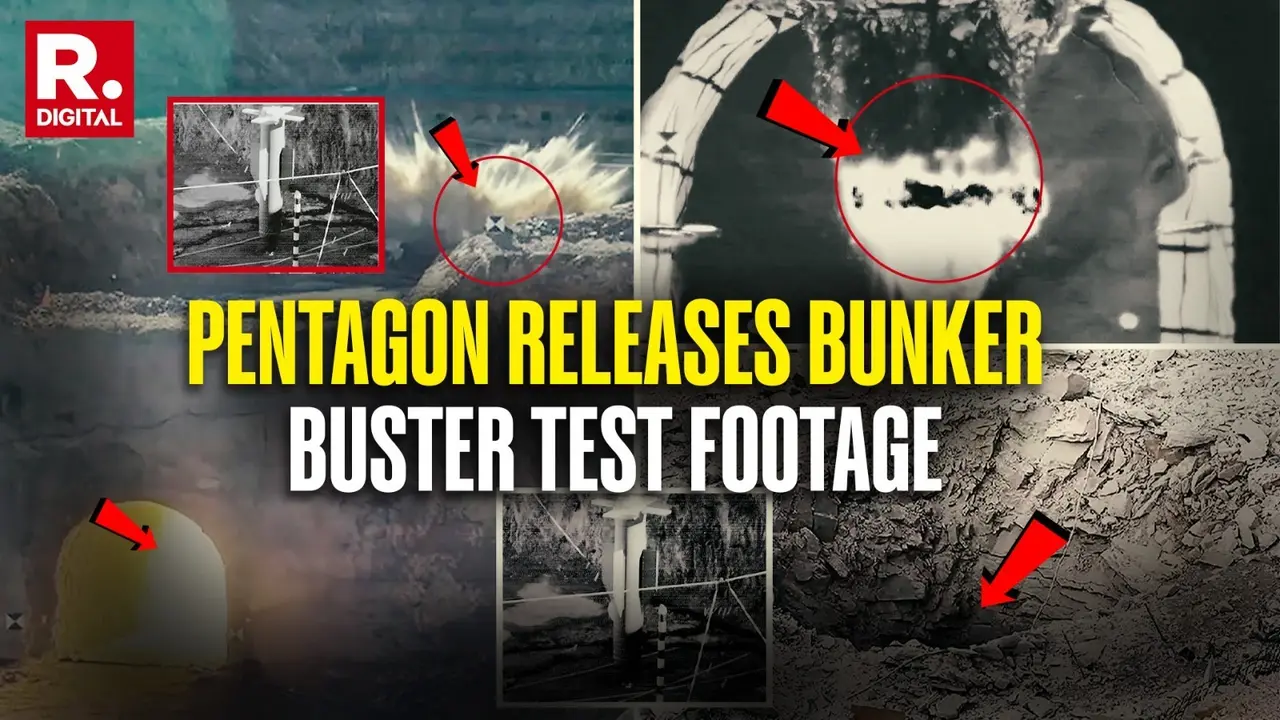Updated 27 June 2025 at 13:01 IST
Watch | US Drops Video Of Bunker-Buster Bombs That Hit Iran After Claims of 'Unsuccessful Strike'
The US releases footage of bunker-buster bombs used in Iran amid claims the strikes were unsuccessful, calling the mission a 'historic success.'
- World News
- 4 min read

Iran-Israel-US Conflict: The Pentagon on Thursday (June 26) released test footage demonstrating how its bunker-buster bombs work, amid claims that recent American strikes on Iran failed to destroy its nuclear sites.
The video shows the test footage of how the GBU-57 A/B Massive Ordnance Penetrator (MOP), America’s most powerful bunker-buster bomb works.
The footage captures the GBU-57 MOP being released from a B-2 stealth bomber at an altitude of around 12 kilometers (7.5 miles) above the target. The bomb, which has no engine, gains immense speed as it drops, using gravity and its heavy weight to build kinetic energy. Guided precisely by satellite navigation and adjustable tail fins, the bomb steers itself toward the target with accuracy.
US Secretary of Defense Pete Hegseth, addressing reporters, said, “Because of the hatred of this press... your people are trying to leak & spin that it wasn't successful. It's irresponsible.” Gen. Dan “Razin” Caine, speaking about the mission, added, “I have chills… talking about this.”
Advertisement
Former President Donald Trump criticised the US media for raising questions based on leaked intelligence reports suggesting the strikes did not damage Iran’s nuclear sites. Trump accused Democrats of leaking the report and called for the prosecution of those responsible, though there is no public evidence supporting his claims. The Trump administration has pledged to pursue those behind the leaks.
Addressing reporters at the Pentagon, Hegseth stated, “Strikes in Iran were highly successful, it was a resounding success and brought the end of the war. Trump created the conditions to end war destroying Iran's nuclear capabilities. What other presidents talked about, President Trump achieved. This is a historic moment.” He added that the leaked preliminary report was based on “lynchpin assumptions,” and noted that Rafael Grossi, Director General of the IAEA, also said the US strikes caused “enormous damage.”
Advertisement
Gen. Dan Caine, chairman of the Joint Chiefs of Staff, said the US received intelligence on Monday that Iran intended to attack US bases in the region, prompting the deployment of Patriot missiles from Korea and Japan, along with Qatari Patriot systems. He added that in the days before the Fordow attacks, Iranian forces had attempted to cover the shafts with concrete.
Meanwhile, Iran’s Supreme Leader Ayatollah Ali Khamenei, in his first appearance since the ceasefire with Israel, accused Trump of exaggerating the strikes’ impact. “The American president exaggerated events in unusual ways, and i t turned out that he needed this exaggeration,” Khamenei said, insisting that the strikes did “nothing significant” to Iran’s nuclear infrastructure.
In the same address, Khamenei warned that any future American attacks on Iran would be met with retaliatory strikes on US military bases across the Middle East, Reuters reported. He said Iran had already shown its willingness to respond by targeting a major US base in Qatar, referring to the recent missile strike on Al Udeid air base. “The Islamic Republic slapped America in the face. It attacked one of the important American bases in the region,” Khamenei declared, adding that Iran would not hesitate to act again if provoked.
How Bunker-Buster Bombs Work?
A bunker-buster bomb is released from a B-2 stealth bomber flying at around 12 km (7.5 miles) above the target, using its high altitude to gain significant speed during the fall, as it has no engine of its own. The bomb is guided by satellite navigation, allowing it to steer using adjustable tail fins for precise targeting. Its heavy weight generates a large amount of kinetic energy upon impact, which helps drive its dense alloy casing deep underground, up to 60 meters (nearly 200 feet) beneath the surface. Finally, a delayed fuse detonates around 2,400 kg of explosives inside the bomb, creating a powerful underground explosion designed to destroy deeply buried bunkers and hardened facilities.
What is the Iran-Israel-US Conflict?
Tensions between Israel and Iran escalated on June 13 when Israel, under Operation Rising Lion, targeted Iranian nuclear sites and killed senior commanders. Iran retaliated with Operation True Promise 3, launching missile and drone attacks on Israeli cities, citing its “right to respond.” The situation worsened with both countries exchanging missile and drone strikes.
The United States entered the conflict on June 21, launching Operation Midnight Hammer and striking the Iranian nuclear sites at Fordow, Natanz, and Isfahan. In retaliation, Iran targeted the Al Udeid air base in Qatar, which hosts US forces.
On June 24, former President Trump announced a ceasefire between Iran and Israel. While the ceasefire initially faltered, it has largely held since then.
Published By : Shruti Sneha
Published On: 27 June 2025 at 12:25 IST
